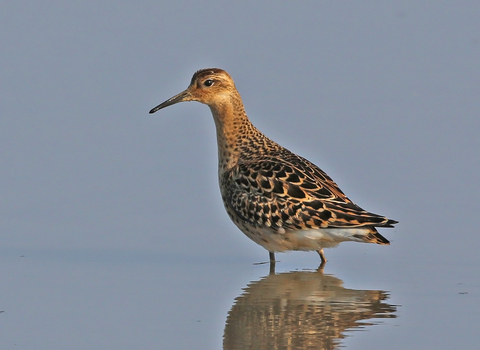
©Margaret Holland
Ruff
The UK hosts a small, but important, breeding population of ruff. The ruff is a large sandpiper that is so-called due to the large ruff of feathers around the males' neck. This is used in a showy display to attract a mate.
Scientific name
Calidris pugnaxWhen to see
January to DecemberSpecies information
Category
Statistics
Length: 26-32cmWingspan: 53cm
Weight: 110-180g
Average lifespan: 4 years
Classified in the UK as Red under the Birds of Conservation Concern 5: the Red List for Birds (2021). Protected in the UK under the Wildlife and Countryside Act, 1981.
Habitats
About
The ruff is a large sandpiper; a typical wader, it feeds in shallow water around lakes and wetland areas near the coast. Just a handful of pairs breed in the UK, but some birds are present all year-round. During summer, young birds on their way to Africa from Scandinavia stopover in the UK.How to identify
Most ruff you will see are fairly plain-looking waders, with a longish neck and small head. Non-breeding birds are pale fawn-brown all over, with a paler belly. Breeding males, however, have a ruff of brightly coloured feathers around the neck, head tufts and a bare, orange face. Ruff have a short, slightly down-curved bill and orangey-yellow legs.Distribution
A very rare breeding bird of wet grasslands in East Anglia. Fairly common on migration at wetlands throughout the country and around the east and south coasts.Did you know?
Female ruff are called 'reeves' and are much smaller than their mates. Male ruff use the large ruff of feathers around their necks in showy displays to attract females. Males with white ruffs are known as 'satellites' and are not usually dominant enough to mate with females, but will sneak couplings when they can.Watch
Ruff (https://vimeo.com/452225131/6791787ee2)
Ruff by John Bridges
